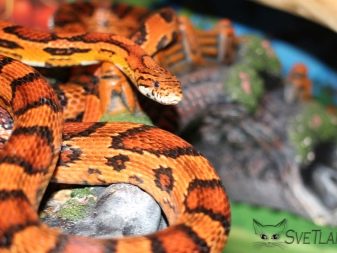What are snake terrariums and how to equip them?
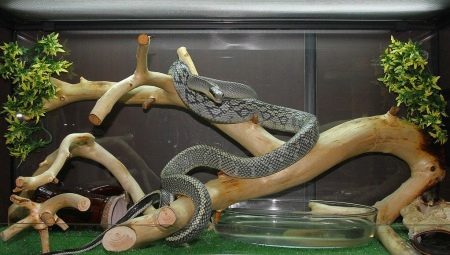
These days, exotic animals, including, of course, reptiles (and cobras are no exception), are no longer supernatural. Now in many houses, apartments and even office premises you can find exclusive pets. However, those wishing to have one should know what terrariums are for different types of snakes and how to properly equip them. It is important to take into account that their content, despite the relative simplicity, will require certain financial costs.



Views
Currently, there are different types of snake enclosures. In this case, we are talking about transparent structures that contain heat-loving reptiles that are not suitable for living in apartments or houses.
It should be noted that in parallel, the terrarium often becomes a decorative element of the interior. The models available today are distinguished by purpose, shape and dimensions.

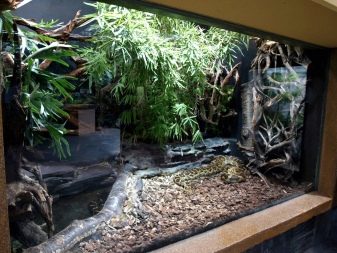
By form
This parameter is determined by the characteristics of pets. Today, the following options for terrariums can be distinguished:
- Horizontal - focused on the maintenance of terrestrial species, preferring not to move on trees and vertical surfaces.
- Vertical - are intended primarily for the habitat of arboreal species.
- Cubic - an intermediate type, the main feature of which is the same linear dimensions. Such models are relevant for snakes, which in their natural environment use both horizontal and vertical surfaces to move.
It should be noted that, regardless of the configuration of the premises in question, it is necessary to take care of their arrangement.In addition to creating a favorable microclimate for terrarium inhabitants, it is worth placing driftwood, shelters and other accessories in the snake dwelling.


By size
Initially, it is necessary to pay attention to the fact that the dimensions of the snake dwelling are determined by the individual characteristics of its future inhabitants. Average indicators in this case are 110x70x70 cm. By the way, experienced breeders do not recommend placing small individuals in a large terrarium right away to avoid stress.
The ideal option is when the diagonal of the base of the structure is commensurate with the body of the inhabitant. As practice shows, such proportions provide the most comfortable living conditions for the reptile, including the microclimate. At the same time, for an inactive snake with a body length of about 2 meters, a terrarium with a diagonal of 1.5 meters will be optimal.


Selection Tips
First of all, you need to decide on the type (shape) of the terrarium. This moment will be determined by the characteristics of the lifestyle of the future tenant. These are the following options:
- Green pythons, boyies and other tree snakes are vertical models.
- Cuban boa constrictor, thin-tailed snake and other representatives of semi-woody species are cubic structures.
- Milk snake, king python and other terrestrial reptiles are horizontal terrariums.

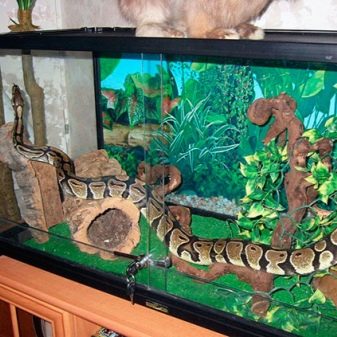
Next, it is important to choose the right dimensions for the structure. Knowing the actual and potential sizes of your pet is not difficult to do this. It is important at this stage to take into account that zones with different temperatures will be created in the terrarium. For land snakes and tree snakes, the key parameters will be length and height, respectively.
For example, for an adult maize snake, a terrarium up to 15 cm high will suffice.


Arrangement
In any terrarium, the most comfortable conditions for the snake should be created. To do this, it must be properly equipped, paying attention when completing every little thing. For beginners, this process may seem simple at first glance.
However, it is important to remember that the health and life expectancy of a pet will directly depend on how competently its home will be designed and equipped.


Heating
Predictably, one of the main points is to ensure the correct temperature regime. It is important to remember that each species has its own optimal performance. But, regardless of such nuances, two temperature zones are created in terrariums, namely: warm and cold corners. Heating elements are placed in the first, while in the second the thermometer readings will be lower, and the humidity, on the contrary, will be higher.
Today, snake dwellings are heated with the following devices:
- thermal cords and thermal stones;
- flat heating elements in the form of rugs;
- ceramic emitters;
- infrared and mirror lamps;
- incandescent lamps.


Water
Any terrarium for snakes, regardless of their species, should be equipped with areas with different humidity. At the same time, it is important that the tenant has the opportunity to comfortably accommodate on each of them.
As a rule, for these purposes, shelters are created in which periodically wetted hygroscopic material is placed. Such zones are called "humidity chambers".
Do not forget about drinking water for the snake, which is vital for most species. As appropriate sources, containers made of glass or food grade plastic are used, the capacity of which depends on the size and biological characteristics of the pet. It is worth noting that most terrestrial domestic reptiles require a minimal amount of water, while semiaquatic species may need a small body of water.

Priming
It is immediately important to note that such a filler for terrariums performs not only a decorative function.The soil in such snake dwellings accumulates moisture, and also represents the environment through which the animal moves and in which it can hide. Do not forget also about the soil for planting plants for the purpose of landscaping the terrarium of the domestic snake.
The list of the most common types of soil includes:
- Potting mix more useful for reptiles living in green environments.
- Sand suitable for arid species.
- Sphagnum, which is hygroscopic and allows you to maintain high humidity.
- Gravel, which will be the optimal solution for keeping snakes that are semi-aquatic or in the water.
- Expanded clay, characterized by porosity and low thermal conductivity.
- Coconut chips with good moisture retention.
In addition to all of the above, large wood chips are often used. This material is easy to clean, which allows you to keep the terrarium clean without much effort and time.

Lighting
Light sources with different characteristics are both conventional incandescent lamps and fluorescent and LED devices. It should always be remembered that terrarium reptiles need ultraviolet radiation to:
- the production of sufficient amounts of vitamin D;
- normalization of mineral metabolism;
- stimulation of reproduction;
- stabilization of behavior.
As a rule, fluorescent lamps help to create a comfortable microclimate for reptiles and amphibians, which, taking into account the UV spectrum, are divided into the following categories:
- With a low UVB content (up to 2%) - mild irradiation of snakes.
- UVB in the range of 4-5% are relevant for keeping reptiles with average radiation requirements.
- UVB from 7 to 10% - designed for terrarium dwellers with an increased need for ultraviolet radiation.
Medical (quartz) and erythemal light sources are used exclusively for treatment sessions.

Ventilation
The operation of the heaters is directly related to the convection movement of air inside the terrarium. You can achieve continuous and at the same time weak circulation by placing ventilation grilles in cold and warm areas. The air exchange rate is adjusted by changing the areas of the inlet and outlet ventilation.
It is worth noting that in a similar way, the humidity and, to some extent, the temperature regime are regulated in parallel.

Shelters
In the overwhelming majority of cases, such constructions are required for keeping many types of snakes. It is important to remember that the hideout does not need to be spacious as the terrarians feel safe in contact with the walls of the shelter. Otherwise, there are no strict requirements for the configuration of structures and materials from which they are made.
The main thing is that the entrance allows the snake to enter with a full stomach.
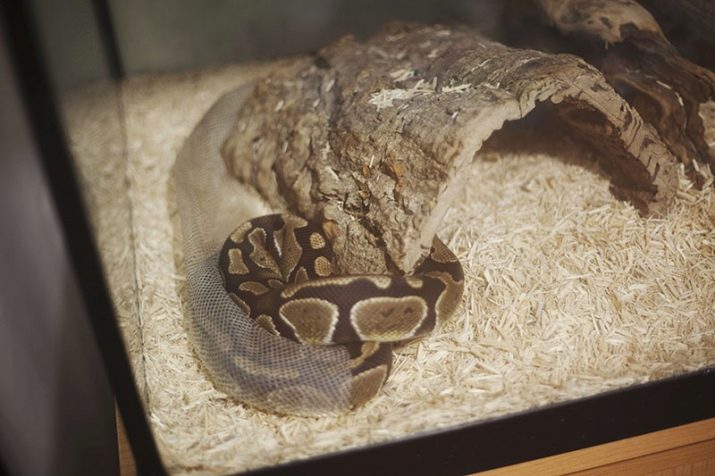
Landscaping
Many snake owners pay special attention to the cultivation of various plants in their terrariums. However, it is worth noting that the presence of natural landscaping is not included in the list of vital and necessary equipping of the habitat of the exotic pets in question. On the other hand, live plants greatly increase the decorative effect of the terrarium itself.
Among other things, representatives of the flora have a beneficial effect on the microclimate. And we are talking, in particular, about the humidity mode.
It is also worth noting that such a design allows you to create comfortable living conditions for small specimens belonging to the species of tree snakes.
